Sedation in the Intensive Care Unit: Drugs and Patient Management
VerifiedAdded on 2023/01/17
|7
|1961
|44
Report
AI Summary
This report provides a comprehensive overview of sedation practices within the Intensive Care Unit (ICU). It begins by defining sedation and its importance in managing critically ill patients, highlighting its role in facilitating endotracheal tube tolerance and ventilator synchronization, while also addressing the risks of oversedation. The report then delves into the specifics of sedative drugs, including Fentanyl and Midazolam, explaining their mechanisms of action and clinical applications. It explores the rationale for replacing Midazolam with Propofol, emphasizing Propofol's advantages in achieving patient-ventilator synchrony and its rapid onset and recovery. Furthermore, the report discusses the role of Dexmedetomidine in managing sedation, particularly for extubation, focusing on its ability to maintain airway patency and facilitate spontaneous respiration. The conclusion summarizes the key points, emphasizing the importance of sedation in various medical procedures and the critical role of different sedative drugs in patient care within the ICU.

SEDATION IN ICU
Paraphrase This Document
Need a fresh take? Get an instant paraphrase of this document with our AI Paraphraser

TABLE OF CONTENTS
INTRODUCTION...........................................................................................................................4
MAIN BODY...................................................................................................................................4
CONCLUSION................................................................................................................................7
REFERENCES................................................................................................................................8
INTRODUCTION...........................................................................................................................4
MAIN BODY...................................................................................................................................4
CONCLUSION................................................................................................................................7
REFERENCES................................................................................................................................8
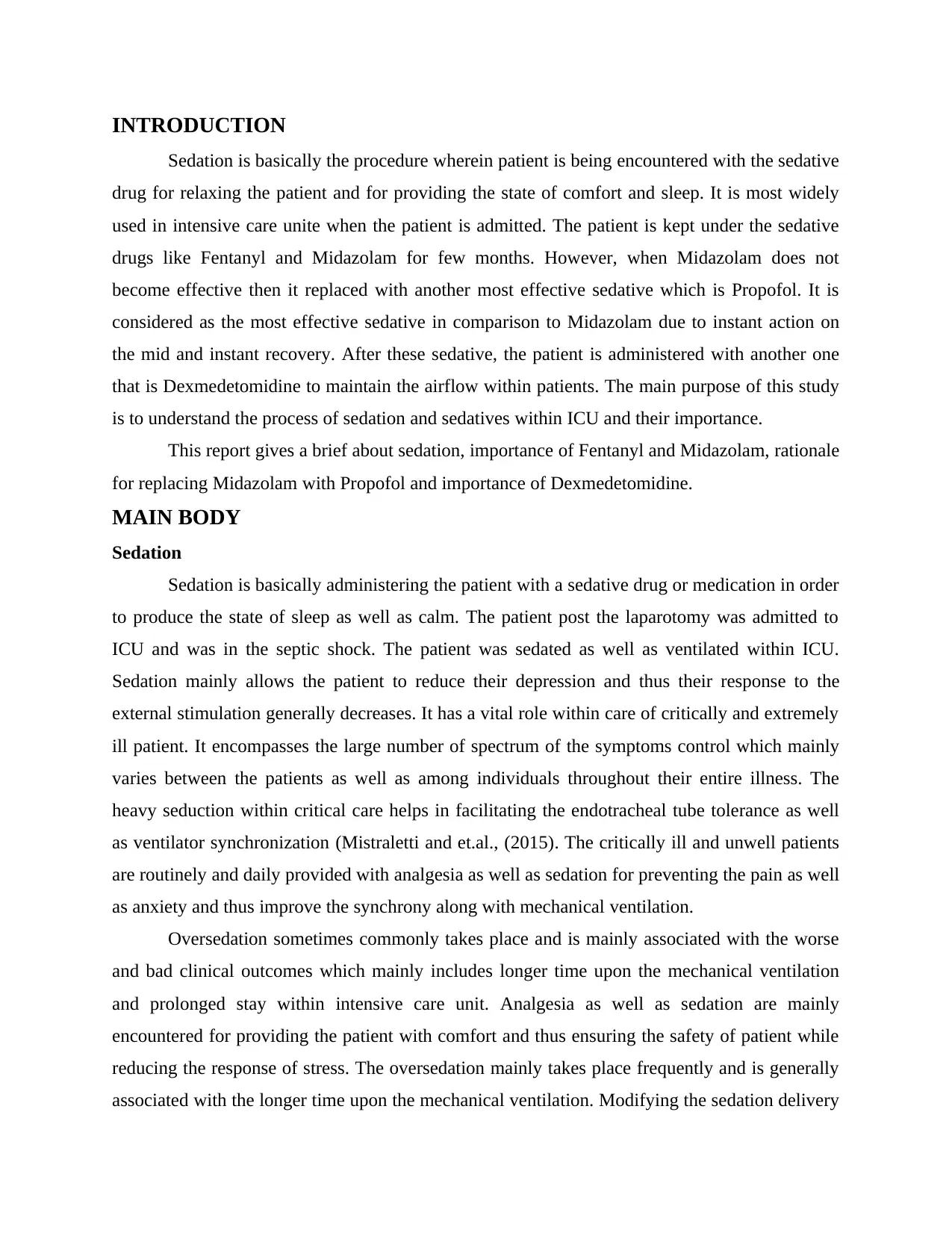
INTRODUCTION
Sedation is basically the procedure wherein patient is being encountered with the sedative
drug for relaxing the patient and for providing the state of comfort and sleep. It is most widely
used in intensive care unite when the patient is admitted. The patient is kept under the sedative
drugs like Fentanyl and Midazolam for few months. However, when Midazolam does not
become effective then it replaced with another most effective sedative which is Propofol. It is
considered as the most effective sedative in comparison to Midazolam due to instant action on
the mid and instant recovery. After these sedative, the patient is administered with another one
that is Dexmedetomidine to maintain the airflow within patients. The main purpose of this study
is to understand the process of sedation and sedatives within ICU and their importance.
This report gives a brief about sedation, importance of Fentanyl and Midazolam, rationale
for replacing Midazolam with Propofol and importance of Dexmedetomidine.
MAIN BODY
Sedation
Sedation is basically administering the patient with a sedative drug or medication in order
to produce the state of sleep as well as calm. The patient post the laparotomy was admitted to
ICU and was in the septic shock. The patient was sedated as well as ventilated within ICU.
Sedation mainly allows the patient to reduce their depression and thus their response to the
external stimulation generally decreases. It has a vital role within care of critically and extremely
ill patient. It encompasses the large number of spectrum of the symptoms control which mainly
varies between the patients as well as among individuals throughout their entire illness. The
heavy seduction within critical care helps in facilitating the endotracheal tube tolerance as well
as ventilator synchronization (Mistraletti and et.al., (2015). The critically ill and unwell patients
are routinely and daily provided with analgesia as well as sedation for preventing the pain as well
as anxiety and thus improve the synchrony along with mechanical ventilation.
Oversedation sometimes commonly takes place and is mainly associated with the worse
and bad clinical outcomes which mainly includes longer time upon the mechanical ventilation
and prolonged stay within intensive care unit. Analgesia as well as sedation are mainly
encountered for providing the patient with comfort and thus ensuring the safety of patient while
reducing the response of stress. The oversedation mainly takes place frequently and is generally
associated with the longer time upon the mechanical ventilation. Modifying the sedation delivery
Sedation is basically the procedure wherein patient is being encountered with the sedative
drug for relaxing the patient and for providing the state of comfort and sleep. It is most widely
used in intensive care unite when the patient is admitted. The patient is kept under the sedative
drugs like Fentanyl and Midazolam for few months. However, when Midazolam does not
become effective then it replaced with another most effective sedative which is Propofol. It is
considered as the most effective sedative in comparison to Midazolam due to instant action on
the mid and instant recovery. After these sedative, the patient is administered with another one
that is Dexmedetomidine to maintain the airflow within patients. The main purpose of this study
is to understand the process of sedation and sedatives within ICU and their importance.
This report gives a brief about sedation, importance of Fentanyl and Midazolam, rationale
for replacing Midazolam with Propofol and importance of Dexmedetomidine.
MAIN BODY
Sedation
Sedation is basically administering the patient with a sedative drug or medication in order
to produce the state of sleep as well as calm. The patient post the laparotomy was admitted to
ICU and was in the septic shock. The patient was sedated as well as ventilated within ICU.
Sedation mainly allows the patient to reduce their depression and thus their response to the
external stimulation generally decreases. It has a vital role within care of critically and extremely
ill patient. It encompasses the large number of spectrum of the symptoms control which mainly
varies between the patients as well as among individuals throughout their entire illness. The
heavy seduction within critical care helps in facilitating the endotracheal tube tolerance as well
as ventilator synchronization (Mistraletti and et.al., (2015). The critically ill and unwell patients
are routinely and daily provided with analgesia as well as sedation for preventing the pain as well
as anxiety and thus improve the synchrony along with mechanical ventilation.
Oversedation sometimes commonly takes place and is mainly associated with the worse
and bad clinical outcomes which mainly includes longer time upon the mechanical ventilation
and prolonged stay within intensive care unit. Analgesia as well as sedation are mainly
encountered for providing the patient with comfort and thus ensuring the safety of patient while
reducing the response of stress. The oversedation mainly takes place frequently and is generally
associated with the longer time upon the mechanical ventilation. Modifying the sedation delivery
⊘ This is a preview!⊘
Do you want full access?
Subscribe today to unlock all pages.

Trusted by 1+ million students worldwide
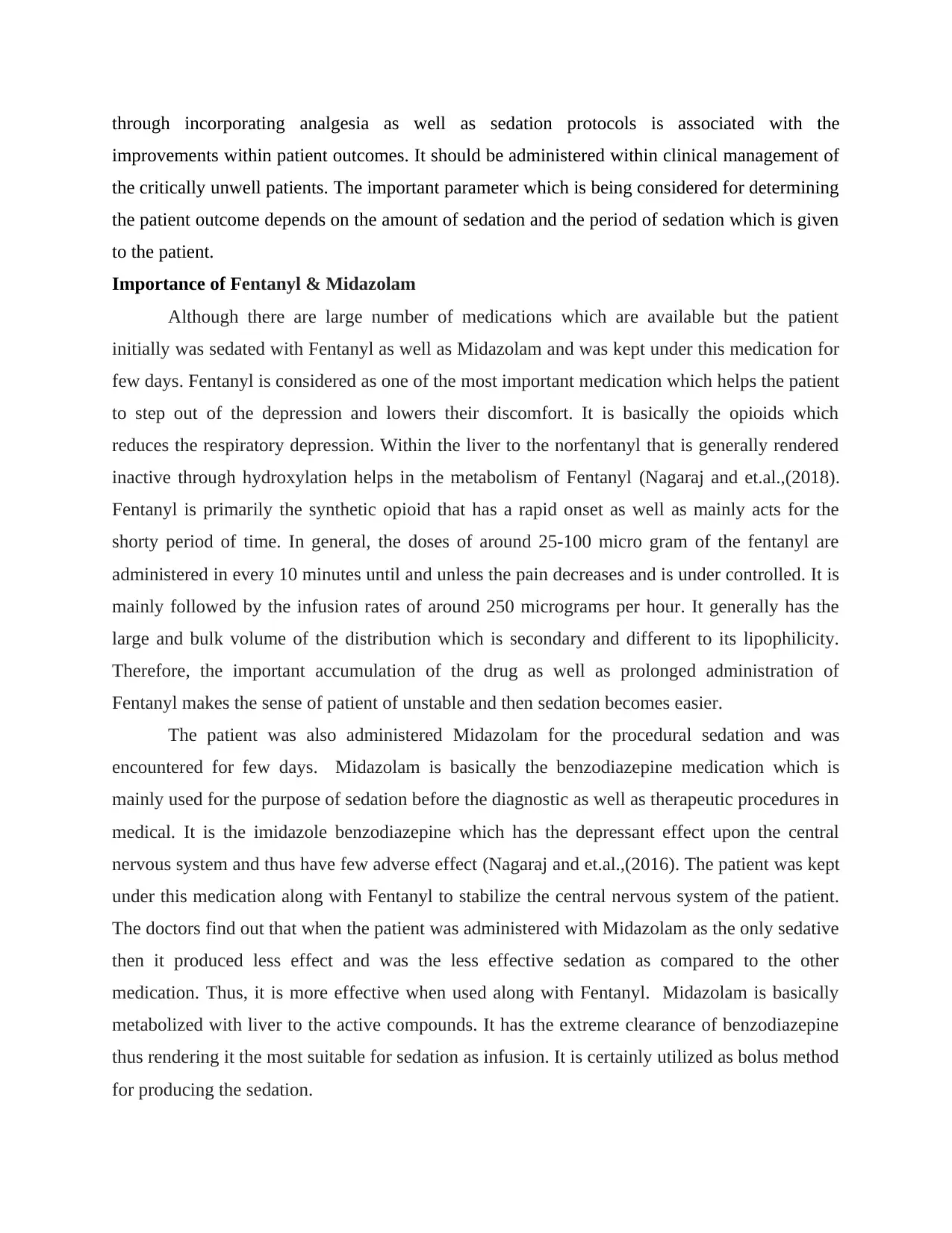
through incorporating analgesia as well as sedation protocols is associated with the
improvements within patient outcomes. It should be administered within clinical management of
the critically unwell patients. The important parameter which is being considered for determining
the patient outcome depends on the amount of sedation and the period of sedation which is given
to the patient.
Importance of Fentanyl & Midazolam
Although there are large number of medications which are available but the patient
initially was sedated with Fentanyl as well as Midazolam and was kept under this medication for
few days. Fentanyl is considered as one of the most important medication which helps the patient
to step out of the depression and lowers their discomfort. It is basically the opioids which
reduces the respiratory depression. Within the liver to the norfentanyl that is generally rendered
inactive through hydroxylation helps in the metabolism of Fentanyl (Nagaraj and et.al.,(2018).
Fentanyl is primarily the synthetic opioid that has a rapid onset as well as mainly acts for the
shorty period of time. In general, the doses of around 25-100 micro gram of the fentanyl are
administered in every 10 minutes until and unless the pain decreases and is under controlled. It is
mainly followed by the infusion rates of around 250 micrograms per hour. It generally has the
large and bulk volume of the distribution which is secondary and different to its lipophilicity.
Therefore, the important accumulation of the drug as well as prolonged administration of
Fentanyl makes the sense of patient of unstable and then sedation becomes easier.
The patient was also administered Midazolam for the procedural sedation and was
encountered for few days. Midazolam is basically the benzodiazepine medication which is
mainly used for the purpose of sedation before the diagnostic as well as therapeutic procedures in
medical. It is the imidazole benzodiazepine which has the depressant effect upon the central
nervous system and thus have few adverse effect (Nagaraj and et.al.,(2016). The patient was kept
under this medication along with Fentanyl to stabilize the central nervous system of the patient.
The doctors find out that when the patient was administered with Midazolam as the only sedative
then it produced less effect and was the less effective sedation as compared to the other
medication. Thus, it is more effective when used along with Fentanyl. Midazolam is basically
metabolized with liver to the active compounds. It has the extreme clearance of benzodiazepine
thus rendering it the most suitable for sedation as infusion. It is certainly utilized as bolus method
for producing the sedation.
improvements within patient outcomes. It should be administered within clinical management of
the critically unwell patients. The important parameter which is being considered for determining
the patient outcome depends on the amount of sedation and the period of sedation which is given
to the patient.
Importance of Fentanyl & Midazolam
Although there are large number of medications which are available but the patient
initially was sedated with Fentanyl as well as Midazolam and was kept under this medication for
few days. Fentanyl is considered as one of the most important medication which helps the patient
to step out of the depression and lowers their discomfort. It is basically the opioids which
reduces the respiratory depression. Within the liver to the norfentanyl that is generally rendered
inactive through hydroxylation helps in the metabolism of Fentanyl (Nagaraj and et.al.,(2018).
Fentanyl is primarily the synthetic opioid that has a rapid onset as well as mainly acts for the
shorty period of time. In general, the doses of around 25-100 micro gram of the fentanyl are
administered in every 10 minutes until and unless the pain decreases and is under controlled. It is
mainly followed by the infusion rates of around 250 micrograms per hour. It generally has the
large and bulk volume of the distribution which is secondary and different to its lipophilicity.
Therefore, the important accumulation of the drug as well as prolonged administration of
Fentanyl makes the sense of patient of unstable and then sedation becomes easier.
The patient was also administered Midazolam for the procedural sedation and was
encountered for few days. Midazolam is basically the benzodiazepine medication which is
mainly used for the purpose of sedation before the diagnostic as well as therapeutic procedures in
medical. It is the imidazole benzodiazepine which has the depressant effect upon the central
nervous system and thus have few adverse effect (Nagaraj and et.al.,(2016). The patient was kept
under this medication along with Fentanyl to stabilize the central nervous system of the patient.
The doctors find out that when the patient was administered with Midazolam as the only sedative
then it produced less effect and was the less effective sedation as compared to the other
medication. Thus, it is more effective when used along with Fentanyl. Midazolam is basically
metabolized with liver to the active compounds. It has the extreme clearance of benzodiazepine
thus rendering it the most suitable for sedation as infusion. It is certainly utilized as bolus method
for producing the sedation.
Paraphrase This Document
Need a fresh take? Get an instant paraphrase of this document with our AI Paraphraser
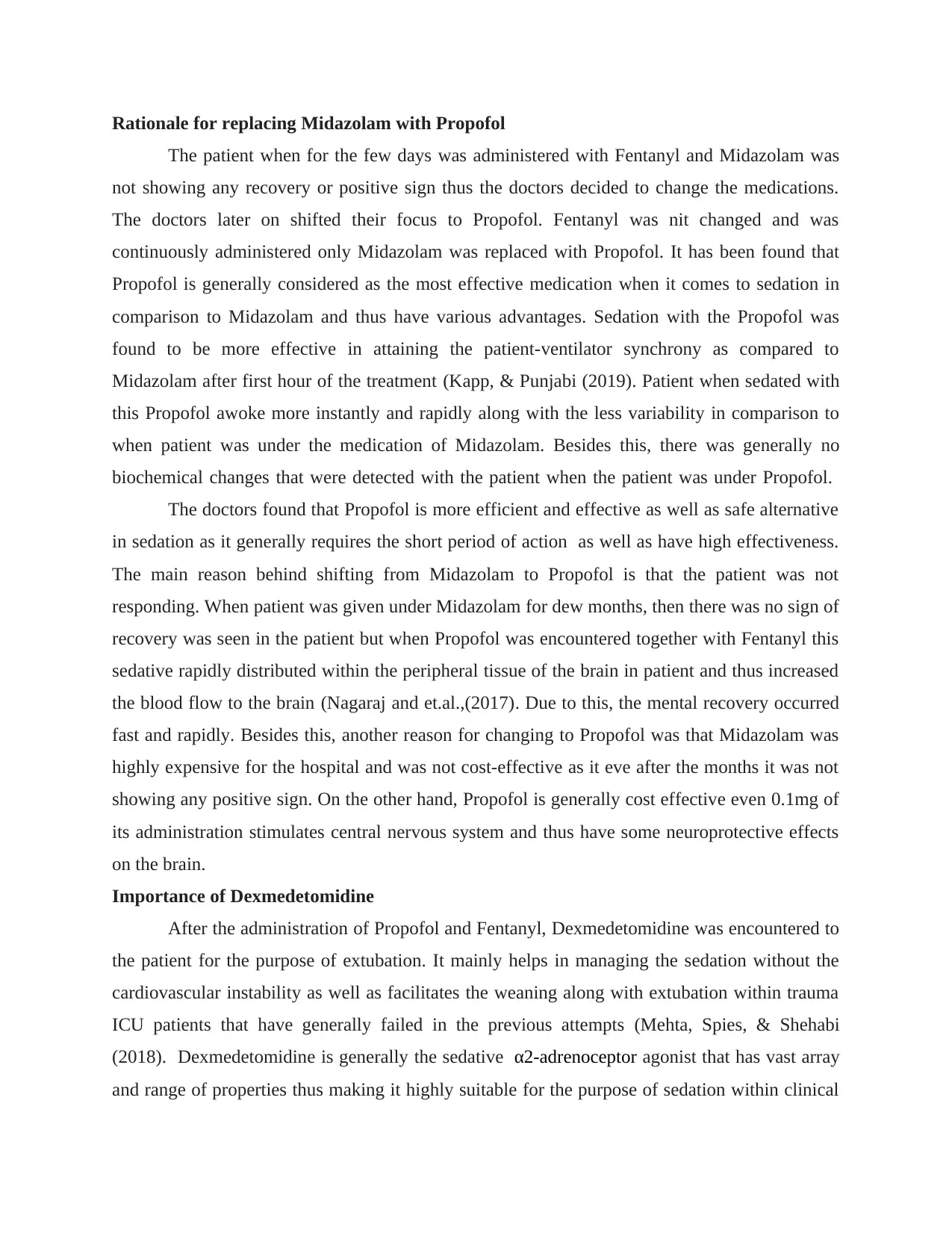
Rationale for replacing Midazolam with Propofol
The patient when for the few days was administered with Fentanyl and Midazolam was
not showing any recovery or positive sign thus the doctors decided to change the medications.
The doctors later on shifted their focus to Propofol. Fentanyl was nit changed and was
continuously administered only Midazolam was replaced with Propofol. It has been found that
Propofol is generally considered as the most effective medication when it comes to sedation in
comparison to Midazolam and thus have various advantages. Sedation with the Propofol was
found to be more effective in attaining the patient-ventilator synchrony as compared to
Midazolam after first hour of the treatment (Kapp, & Punjabi (2019). Patient when sedated with
this Propofol awoke more instantly and rapidly along with the less variability in comparison to
when patient was under the medication of Midazolam. Besides this, there was generally no
biochemical changes that were detected with the patient when the patient was under Propofol.
The doctors found that Propofol is more efficient and effective as well as safe alternative
in sedation as it generally requires the short period of action as well as have high effectiveness.
The main reason behind shifting from Midazolam to Propofol is that the patient was not
responding. When patient was given under Midazolam for dew months, then there was no sign of
recovery was seen in the patient but when Propofol was encountered together with Fentanyl this
sedative rapidly distributed within the peripheral tissue of the brain in patient and thus increased
the blood flow to the brain (Nagaraj and et.al.,(2017). Due to this, the mental recovery occurred
fast and rapidly. Besides this, another reason for changing to Propofol was that Midazolam was
highly expensive for the hospital and was not cost-effective as it eve after the months it was not
showing any positive sign. On the other hand, Propofol is generally cost effective even 0.1mg of
its administration stimulates central nervous system and thus have some neuroprotective effects
on the brain.
Importance of Dexmedetomidine
After the administration of Propofol and Fentanyl, Dexmedetomidine was encountered to
the patient for the purpose of extubation. It mainly helps in managing the sedation without the
cardiovascular instability as well as facilitates the weaning along with extubation within trauma
ICU patients that have generally failed in the previous attempts (Mehta, Spies, & Shehabi
(2018). Dexmedetomidine is generally the sedative α2-adrenoceptor agonist that has vast array
and range of properties thus making it highly suitable for the purpose of sedation within clinical
The patient when for the few days was administered with Fentanyl and Midazolam was
not showing any recovery or positive sign thus the doctors decided to change the medications.
The doctors later on shifted their focus to Propofol. Fentanyl was nit changed and was
continuously administered only Midazolam was replaced with Propofol. It has been found that
Propofol is generally considered as the most effective medication when it comes to sedation in
comparison to Midazolam and thus have various advantages. Sedation with the Propofol was
found to be more effective in attaining the patient-ventilator synchrony as compared to
Midazolam after first hour of the treatment (Kapp, & Punjabi (2019). Patient when sedated with
this Propofol awoke more instantly and rapidly along with the less variability in comparison to
when patient was under the medication of Midazolam. Besides this, there was generally no
biochemical changes that were detected with the patient when the patient was under Propofol.
The doctors found that Propofol is more efficient and effective as well as safe alternative
in sedation as it generally requires the short period of action as well as have high effectiveness.
The main reason behind shifting from Midazolam to Propofol is that the patient was not
responding. When patient was given under Midazolam for dew months, then there was no sign of
recovery was seen in the patient but when Propofol was encountered together with Fentanyl this
sedative rapidly distributed within the peripheral tissue of the brain in patient and thus increased
the blood flow to the brain (Nagaraj and et.al.,(2017). Due to this, the mental recovery occurred
fast and rapidly. Besides this, another reason for changing to Propofol was that Midazolam was
highly expensive for the hospital and was not cost-effective as it eve after the months it was not
showing any positive sign. On the other hand, Propofol is generally cost effective even 0.1mg of
its administration stimulates central nervous system and thus have some neuroprotective effects
on the brain.
Importance of Dexmedetomidine
After the administration of Propofol and Fentanyl, Dexmedetomidine was encountered to
the patient for the purpose of extubation. It mainly helps in managing the sedation without the
cardiovascular instability as well as facilitates the weaning along with extubation within trauma
ICU patients that have generally failed in the previous attempts (Mehta, Spies, & Shehabi
(2018). Dexmedetomidine is generally the sedative α2-adrenoceptor agonist that has vast array
and range of properties thus making it highly suitable for the purpose of sedation within clinical
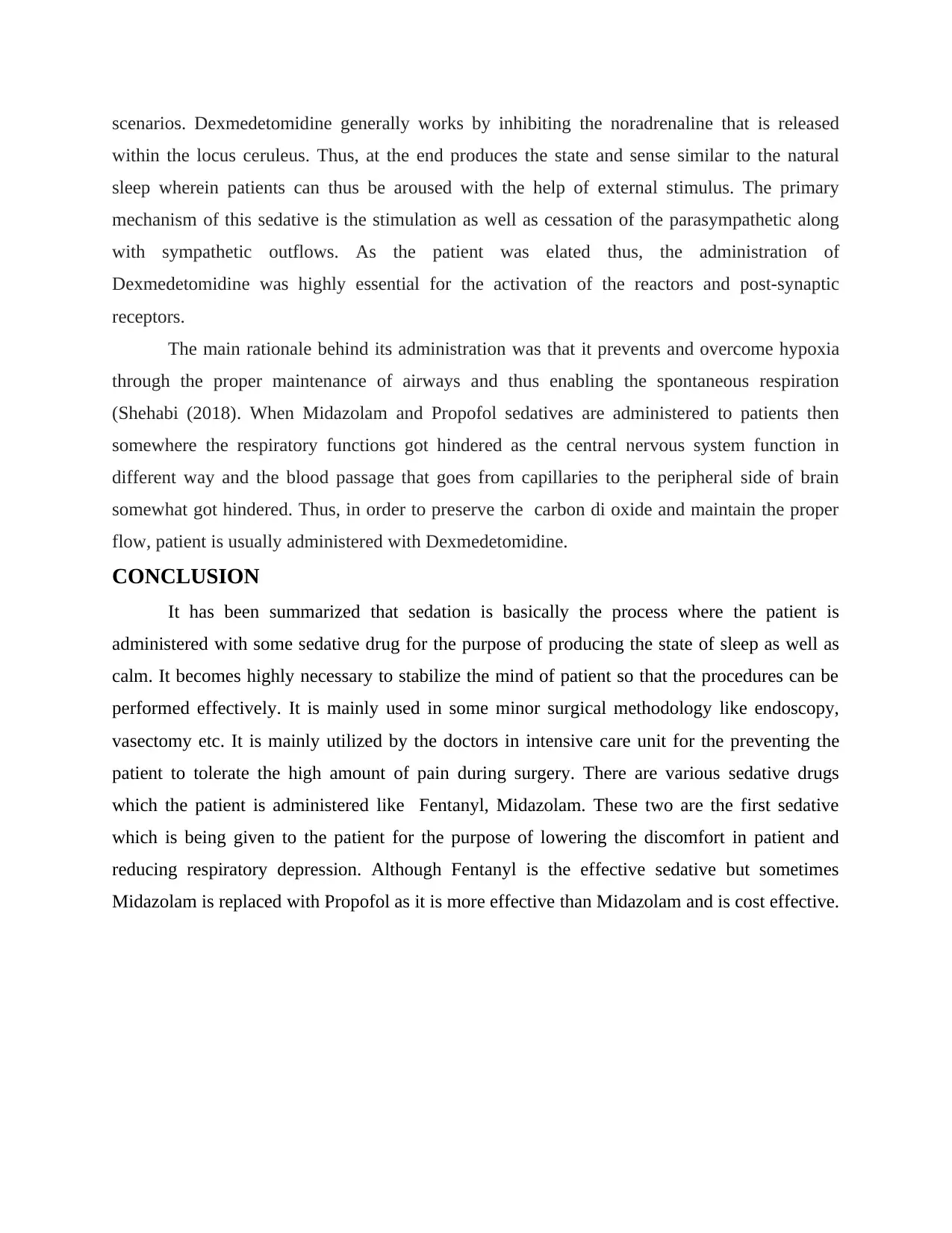
scenarios. Dexmedetomidine generally works by inhibiting the noradrenaline that is released
within the locus ceruleus. Thus, at the end produces the state and sense similar to the natural
sleep wherein patients can thus be aroused with the help of external stimulus. The primary
mechanism of this sedative is the stimulation as well as cessation of the parasympathetic along
with sympathetic outflows. As the patient was elated thus, the administration of
Dexmedetomidine was highly essential for the activation of the reactors and post-synaptic
receptors.
The main rationale behind its administration was that it prevents and overcome hypoxia
through the proper maintenance of airways and thus enabling the spontaneous respiration
(Shehabi (2018). When Midazolam and Propofol sedatives are administered to patients then
somewhere the respiratory functions got hindered as the central nervous system function in
different way and the blood passage that goes from capillaries to the peripheral side of brain
somewhat got hindered. Thus, in order to preserve the carbon di oxide and maintain the proper
flow, patient is usually administered with Dexmedetomidine.
CONCLUSION
It has been summarized that sedation is basically the process where the patient is
administered with some sedative drug for the purpose of producing the state of sleep as well as
calm. It becomes highly necessary to stabilize the mind of patient so that the procedures can be
performed effectively. It is mainly used in some minor surgical methodology like endoscopy,
vasectomy etc. It is mainly utilized by the doctors in intensive care unit for the preventing the
patient to tolerate the high amount of pain during surgery. There are various sedative drugs
which the patient is administered like Fentanyl, Midazolam. These two are the first sedative
which is being given to the patient for the purpose of lowering the discomfort in patient and
reducing respiratory depression. Although Fentanyl is the effective sedative but sometimes
Midazolam is replaced with Propofol as it is more effective than Midazolam and is cost effective.
within the locus ceruleus. Thus, at the end produces the state and sense similar to the natural
sleep wherein patients can thus be aroused with the help of external stimulus. The primary
mechanism of this sedative is the stimulation as well as cessation of the parasympathetic along
with sympathetic outflows. As the patient was elated thus, the administration of
Dexmedetomidine was highly essential for the activation of the reactors and post-synaptic
receptors.
The main rationale behind its administration was that it prevents and overcome hypoxia
through the proper maintenance of airways and thus enabling the spontaneous respiration
(Shehabi (2018). When Midazolam and Propofol sedatives are administered to patients then
somewhere the respiratory functions got hindered as the central nervous system function in
different way and the blood passage that goes from capillaries to the peripheral side of brain
somewhat got hindered. Thus, in order to preserve the carbon di oxide and maintain the proper
flow, patient is usually administered with Dexmedetomidine.
CONCLUSION
It has been summarized that sedation is basically the process where the patient is
administered with some sedative drug for the purpose of producing the state of sleep as well as
calm. It becomes highly necessary to stabilize the mind of patient so that the procedures can be
performed effectively. It is mainly used in some minor surgical methodology like endoscopy,
vasectomy etc. It is mainly utilized by the doctors in intensive care unit for the preventing the
patient to tolerate the high amount of pain during surgery. There are various sedative drugs
which the patient is administered like Fentanyl, Midazolam. These two are the first sedative
which is being given to the patient for the purpose of lowering the discomfort in patient and
reducing respiratory depression. Although Fentanyl is the effective sedative but sometimes
Midazolam is replaced with Propofol as it is more effective than Midazolam and is cost effective.
⊘ This is a preview!⊘
Do you want full access?
Subscribe today to unlock all pages.

Trusted by 1+ million students worldwide
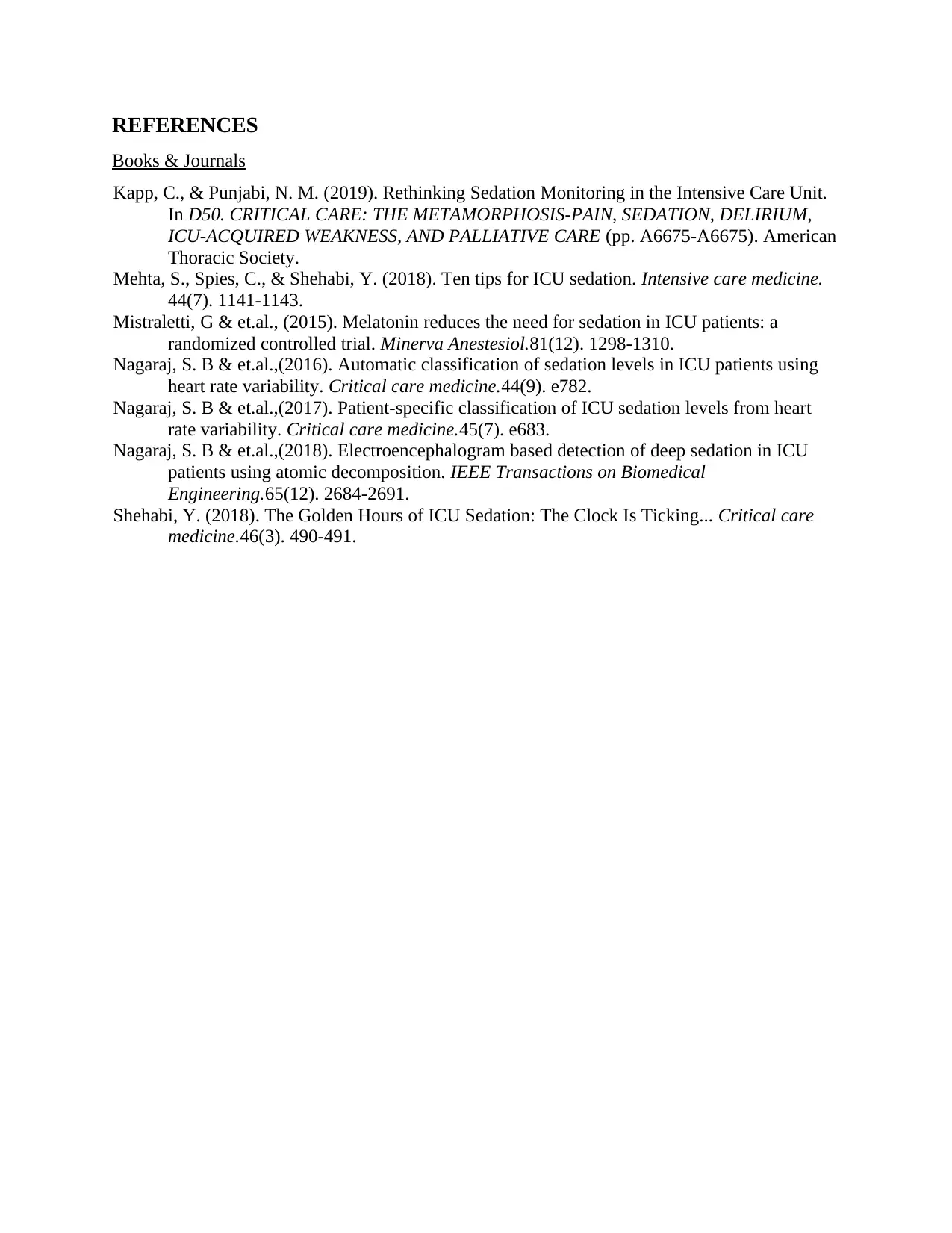
REFERENCES
Books & Journals
Kapp, C., & Punjabi, N. M. (2019). Rethinking Sedation Monitoring in the Intensive Care Unit.
In D50. CRITICAL CARE: THE METAMORPHOSIS-PAIN, SEDATION, DELIRIUM,
ICU-ACQUIRED WEAKNESS, AND PALLIATIVE CARE (pp. A6675-A6675). American
Thoracic Society.
Mehta, S., Spies, C., & Shehabi, Y. (2018). Ten tips for ICU sedation. Intensive care medicine.
44(7). 1141-1143.
Mistraletti, G & et.al., (2015). Melatonin reduces the need for sedation in ICU patients: a
randomized controlled trial. Minerva Anestesiol.81(12). 1298-1310.
Nagaraj, S. B & et.al.,(2016). Automatic classification of sedation levels in ICU patients using
heart rate variability. Critical care medicine.44(9). e782.
Nagaraj, S. B & et.al.,(2017). Patient-specific classification of ICU sedation levels from heart
rate variability. Critical care medicine.45(7). e683.
Nagaraj, S. B & et.al.,(2018). Electroencephalogram based detection of deep sedation in ICU
patients using atomic decomposition. IEEE Transactions on Biomedical
Engineering.65(12). 2684-2691.
Shehabi, Y. (2018). The Golden Hours of ICU Sedation: The Clock Is Ticking... Critical care
medicine.46(3). 490-491.
Books & Journals
Kapp, C., & Punjabi, N. M. (2019). Rethinking Sedation Monitoring in the Intensive Care Unit.
In D50. CRITICAL CARE: THE METAMORPHOSIS-PAIN, SEDATION, DELIRIUM,
ICU-ACQUIRED WEAKNESS, AND PALLIATIVE CARE (pp. A6675-A6675). American
Thoracic Society.
Mehta, S., Spies, C., & Shehabi, Y. (2018). Ten tips for ICU sedation. Intensive care medicine.
44(7). 1141-1143.
Mistraletti, G & et.al., (2015). Melatonin reduces the need for sedation in ICU patients: a
randomized controlled trial. Minerva Anestesiol.81(12). 1298-1310.
Nagaraj, S. B & et.al.,(2016). Automatic classification of sedation levels in ICU patients using
heart rate variability. Critical care medicine.44(9). e782.
Nagaraj, S. B & et.al.,(2017). Patient-specific classification of ICU sedation levels from heart
rate variability. Critical care medicine.45(7). e683.
Nagaraj, S. B & et.al.,(2018). Electroencephalogram based detection of deep sedation in ICU
patients using atomic decomposition. IEEE Transactions on Biomedical
Engineering.65(12). 2684-2691.
Shehabi, Y. (2018). The Golden Hours of ICU Sedation: The Clock Is Ticking... Critical care
medicine.46(3). 490-491.
1 out of 7
Your All-in-One AI-Powered Toolkit for Academic Success.
+13062052269
info@desklib.com
Available 24*7 on WhatsApp / Email
![[object Object]](/_next/static/media/star-bottom.7253800d.svg)
Unlock your academic potential
Copyright © 2020–2025 A2Z Services. All Rights Reserved. Developed and managed by ZUCOL.